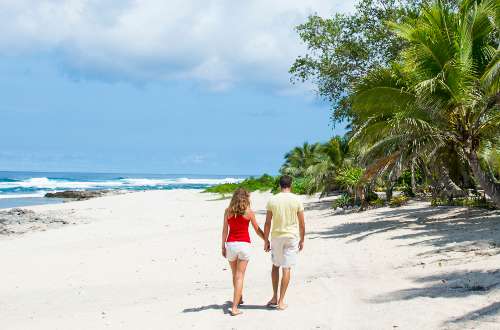Into Vanuatu’s Volcanic Wonderland
BY JEFFREY MARLOW
[huge_it_slider id=”2″]
The South Pacific island nation of Vanuatu, a short hop west of Fiji, is a verdant wonderland, the very embodiment of a tropical paradise. Palm fringed beaches look out toward blue waters that host vibrant ecosystems, while jungles thick with ferns and technicolor flowers burst from the fertile soil.
But as I trek through the thick forest and crest a hill, sweat dripping from my forehead and legs protesting the entire endeavor, I see something in the distance that is very much off-brand. At the heart of this tropical paradise – indeed, the cause of its creation – is a network of powerful volcanoes that comprise the southwestern edge of the notorious Ring of Fire. It’s not all Mai Tais and paragliding in Vanuatu, and the thick plume of volcanic gases in the distance was undeniable proof.
I found myself in this remote corner of the globe, staring at evidence of powerful, planet forming forces, as the chief scientist of an ambitious expedition to descend into Marum Crater and stand on the shore of its infamous lava lake*. Rappelling hundreds of meters down, toward a gurgling cauldron of molten rock doesn’t exactly correspond with well-evolved self preservation instincts, but the scientific upside was appealing. At the bottom of Marum Crater, new rock was constantly being created, while toxic sulfur dioxide gas swirled and mineralogical deposits created a colorful palette of stained rock. As a geobiologist interested in microbiological adaptations to energetically extreme and biochemically exotic sites, I was intrigued.
But getting to this alluring sampling point was not easy, and three hours into the humid hike toward the Marum Crater rim, exhaustion was starting to set in. 40 hours earlier, I had scampered out of the Moscone Convention Center in San Francisco – where 20,000+ plaid-clad geoscientists were gathered for the annual American Geophysical Union conference – and boarded a plane for the South Pacific. It was a gradual retreat from civilization: first Fiji, with concentric rinds of resorts ringing the beaches, then Port Vila, Vanuatu’s leafy capital that swells with capitalistic fever when a cruise ship drops anchor, and finally Ambrym Island, with its grass airstrip and 60 square-foot “airport”.
It was there that I met Moses, a soft-spoken, deliberate man who summoned one of the four vehicles on the eastern side of the island to transport me to the village of Endu. (When I next saw Moses, about a week later, he would be sporting ceremonial dress in his capacity as village chief.) The road was distinguishable as a thick horizon of ferns, grasses, and small trees – as opposed to the utterly impenetrable curtain of green that extended in all other directions.
From Endu, the trek began, first along the black sand beach, then upward and into the forest. I learned the hard way that hazards were both below (moss-slickened tree roots) and above (fishing net-sized spider webs). Fortunately, “Ambrym has no poisonous spiders,” my guide Solomon continued to remind me, unaware that even harmless arachnids could be off-putting when they were the size of your hand. “Nothing can harm you here.”
Except, of course, for the 4200-foot tall volcano that was fuming in the distance, and whose very active past was evidenced by the basalt we had been hiking over for the better part of the morning. First-hand accounts of previous eruptions go back more than a century: grainy images taken just offshore show clouds of ash, black-and-white placidity masking the power of the explosions that formed the island. The 1913 eruptive events put Ambrym on the map – literally and figuratively – by extending the westward edge of the island and offering volcanologists an intriguing case study of a fissure eruption. A 19-km rift opened up, spewing ash and gushing lava, which flowed into the hissing sea and forced a hasty evacuation of the nearby missionary hospital (1). Today, the scars of 1913 are hidden beneath the jungle.
The tortured geologic history of the rest of the island can be read through the black and green landscape. As we came down from the ridge that offered the first view of Marum’s plume, we stepped onto a lava river, frozen in place in 1989 and now punctuated by a few ambitious shrubs. We plunged back into the forest, spider web radar re-activated, to cross deposits from eruptions in the early 1900s, emerging onto a hummocky expanse of tall grasses and beautiful orchids – the current inhabitants of lava flows from the 1960s. Ecological succession on Ambrym is textbook-clear – uninhibited by potential environmental limitations like rainfall – and the force with which we wielded the machete was proportional to the age of the terrain we walked over.
Past the orchids and the most perfect cinder cone I’d ever seen (location scouts take note), we arrived at camp – half a dozen tents perched on the rim of Marum Crater. The camp looked like a fortress, complete with moats and wind-battered flags that provided evidence of the torrential downpour I had narrowly missed. The barren basaltic rim was an incongruous no-man’s land: look south, and you see one of the most lush places on the planet. Look down, and you see thin needles of volcanic glass (known as “Pele’s hair”) scattered on top of small ash spherules and crushed basaltic rocks, unmistakable evidence of recent volcanic activity.
But look north, over the sheer cliff of Marum’s rim and down into the multi-colored crater, and you see something utterly unfamiliar. A violent orange glow, a fluorescent punch that I hadn’t thought was on the possible spectrum of natural hues, churns blebs of rock skyward before consuming them once more. The volcano is mesmerizing, and the heat can be felt even from the rim, 1200 feet above the fiery pit.
The lava lake of Marum is also a geological conundrum. Most volcanic eruptions are short-term events that quickly equilibrate an energetic imbalance. Only about 1% of eruptions persist for more than a decade (2); Marum has been active for at least the last 15 years, according to close observers (3). Understanding where the lava is sourced from – a deep mantle-based reservoir or a shallower repository that may extend laterally across Ambrym – may help clarify how these features form and remain so incredibly active.
After setting up my tent-based laboratory (dirt-encrusted clothes in one corner, sealed sterile tubes for biological samples in the other), I step outside and notice that half the sky is lit up like a nightlight. The volcano’s gaseous plume extends upward into the night, illuminated from below like a mile-tall, convecting lantern. The nearly full moon glints off the water far in the distance, doing battle with the constant sun emanating from within Marum Crater.





